从接受美学视角探讨广告翻译
- 格式:doc
- 大小:28.50 KB
- 文档页数:3
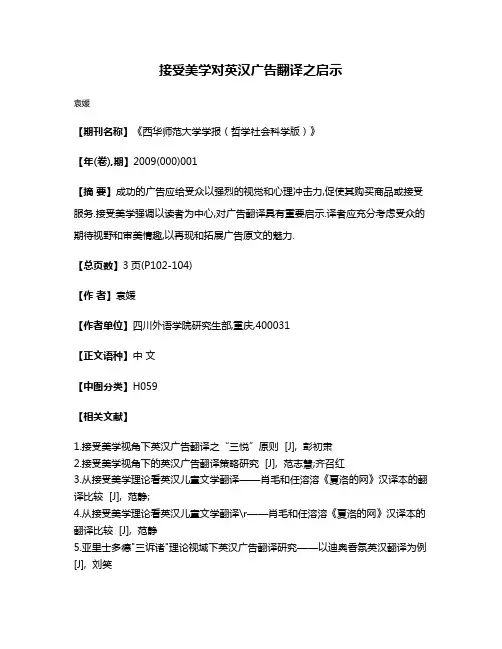
接受美学对英汉广告翻译之启示
袁媛
【期刊名称】《西华师范大学学报(哲学社会科学版)》
【年(卷),期】2009(000)001
【摘要】成功的广告应给受众以强烈的视觉和心理冲击力,促使其购买商品或接受服务.接受美学强调以读者为中心,对广告翻译具有重要启示.译者应充分考虑受众的期待视野和审美情趣,以再现和拓展广告原文的魅力.
【总页数】3页(P102-104)
【作者】袁媛
【作者单位】四川外语学院研究生部,重庆,400031
【正文语种】中文
【中图分类】H059
【相关文献】
1.接受美学视角下英汉广告翻译之“三悦”原则 [J], 彭初肃
2.接受美学视角下的英汉广告翻译策略研究 [J], 范志慧;齐召红
3.从接受美学理论看英汉儿童文学翻译——肖毛和任溶溶《夏洛的网》汉译本的翻译比较 [J], 范静;
4.从接受美学理论看英汉儿童文学翻译\r——肖毛和任溶溶《夏洛的网》汉译本的翻译比较 [J], 范静
5.亚里士多德"三诉诸"理论视域下英汉广告翻译研究——以迪奥香氛英汉翻译为例[J], 刘笑
因版权原因,仅展示原文概要,查看原文内容请购买。
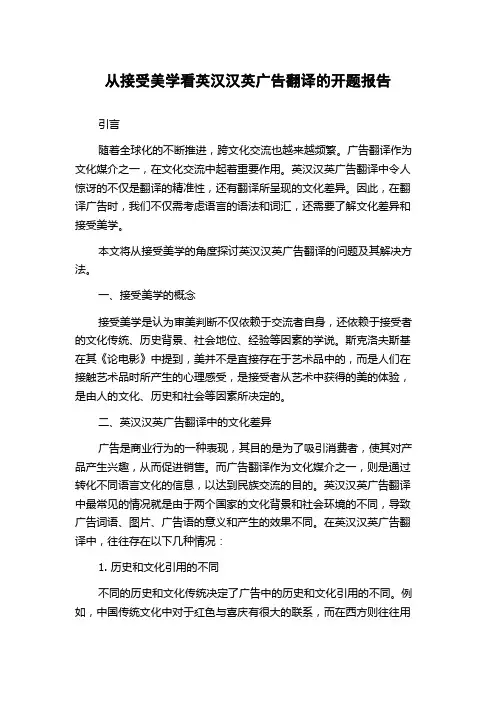
从接受美学看英汉汉英广告翻译的开题报告引言随着全球化的不断推进,跨文化交流也越来越频繁。
广告翻译作为文化媒介之一,在文化交流中起着重要作用。
英汉汉英广告翻译中令人惊讶的不仅是翻译的精准性,还有翻译所呈现的文化差异。
因此,在翻译广告时,我们不仅需考虑语言的语法和词汇,还需要了解文化差异和接受美学。
本文将从接受美学的角度探讨英汉汉英广告翻译的问题及其解决方法。
一、接受美学的概念接受美学是认为审美判断不仅依赖于交流者自身,还依赖于接受者的文化传统、历史背景、社会地位、经验等因素的学说。
斯克洛夫斯基在其《论电影》中提到,美并不是直接存在于艺术品中的,而是人们在接触艺术品时所产生的心理感受,是接受者从艺术中获得的美的体验,是由人的文化、历史和社会等因素所决定的。
二、英汉汉英广告翻译中的文化差异广告是商业行为的一种表现,其目的是为了吸引消费者,使其对产品产生兴趣,从而促进销售。
而广告翻译作为文化媒介之一,则是通过转化不同语言文化的信息,以达到民族交流的目的。
英汉汉英广告翻译中最常见的情况就是由于两个国家的文化背景和社会环境的不同,导致广告词语、图片、广告语的意义和产生的效果不同。
在英汉汉英广告翻译中,往往存在以下几种情况:1. 历史和文化引用的不同不同的历史和文化传统决定了广告中的历史和文化引用的不同。
例如,中国传统文化中对于红色与喜庆有很大的联系,而在西方则往往用黑色、白色代表庄重和高级感。
因此在广告翻译时,需要根据不同文化背景,选择合适的颜色、场景进行准确翻译。
2. 社会习惯、风俗与文化差异社会习惯、风俗与文化差异也是广告翻译中必须考虑到的因素。
例如在中国,过年时需要与家人吃饺子,在西方过圣诞节则需要送礼物等。
这些都是因为不同国家和地区的社会背景和风俗习惯不同,广告翻译需要根据文化差异去做必要的调整。
3. 语言习惯的不同语言的差异也会导致广告中含有难以直接翻译的成分,例如汉语中的“吃瓜群众”、“狗粮”等,需要使用适当的翻译手法进行翻译。
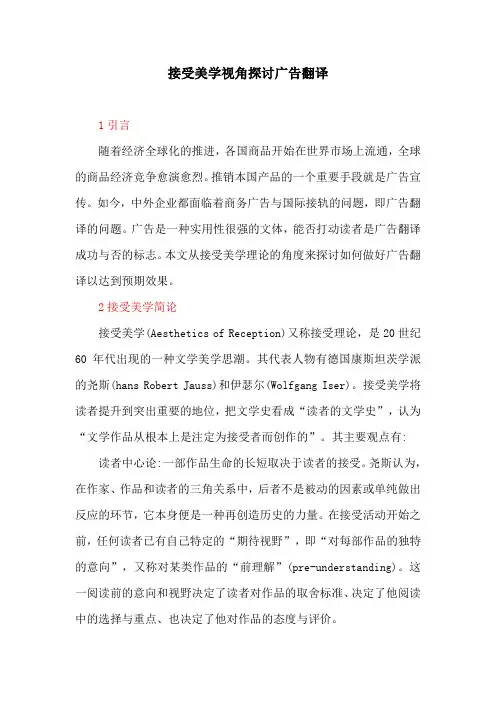
接受美学视角探讨广告翻译1引言随着经济全球化的推进,各国商品开始在世界市场上流通,全球的商品经济竞争愈演愈烈。
推销本国产品的一个重要手段就是广告宣传。
如今,中外企业都面临着商务广告与国际接轨的问题,即广告翻译的问题。
广告是一种实用性很强的文体,能否打动读者是广告翻译成功与否的标志。
本文从接受美学理论的角度来探讨如何做好广告翻译以达到预期效果。
2接受美学简论接受美学(Aesthetics of Reception)又称接受理论,是20世纪60年代出现的一种文学美学思潮。
其代表人物有德国康斯坦茨学派的尧斯(hans Robert Jauss)和伊瑟尔(Wolfgang Iser)。
接受美学将读者提升到突出重要的地位,把文学史看成“读者的文学史”,认为“文学作品从根本上是注定为接受者而创作的”。
其主要观点有读者中心论:一部作品生命的长短取决于读者的接受。
尧斯认为,在作家、作品和读者的三角关系中,后者不是被动的因素或单纯做出反应的环节,它本身便是一种再创造历史的力量。
在接受活动开始之前,任何读者已有自己特定的“期待视野”,即“对每部作品的独特的意向”,又称对某类作品的“前理解”(pre-understanding)。
这一阅读前的意向和视野决定了读者对作品的取舍标准、决定了他阅读中的选择与重点、也决定了他对作品的态度与评价。
审美经验论:读者在阅读作品之前,头脑中已有一系列自觉或不自觉的准备,如审美经验、生活经验和鉴赏能力等。
当新作品唤起读者对同类或有关作品的过去的审美经验时,读者会把过去的经验视界和眼前的作品所体现的新视界做出想象的对比。
审美经验使人产生一种潜反射的审美态度,如读者在生活中接触到大量的人物事件,在阅读中发现有虚假现象就会自然的产生一种抵制接受,形成与作品的审美意象对峙的观点。
召唤结构说:阅读是读者想象性再创造的过程。
一部作品的本文“为读者唤起熟知的来自较早本文的期待和规则的世界,那样,这些较早的本文就被改动、修正、改变,或者甚至干脆重新制作了”。
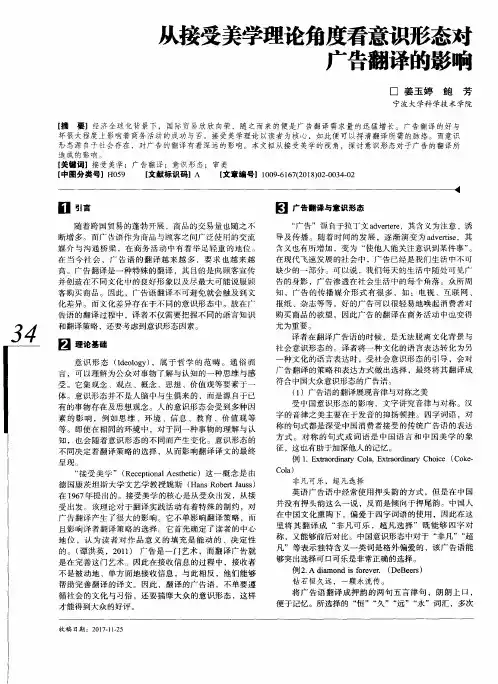
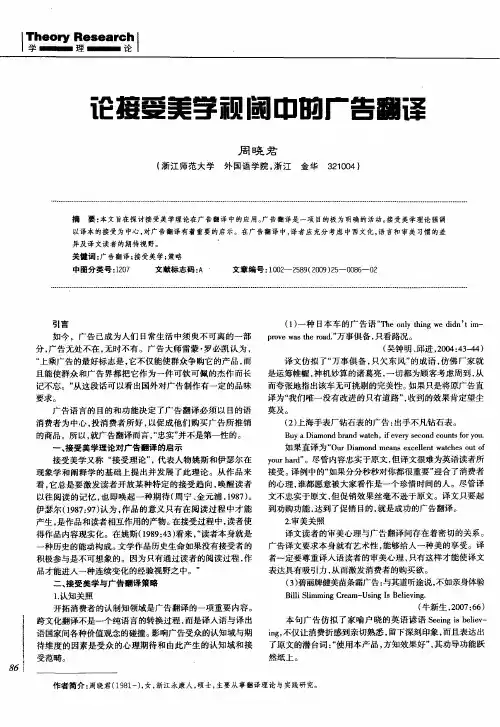
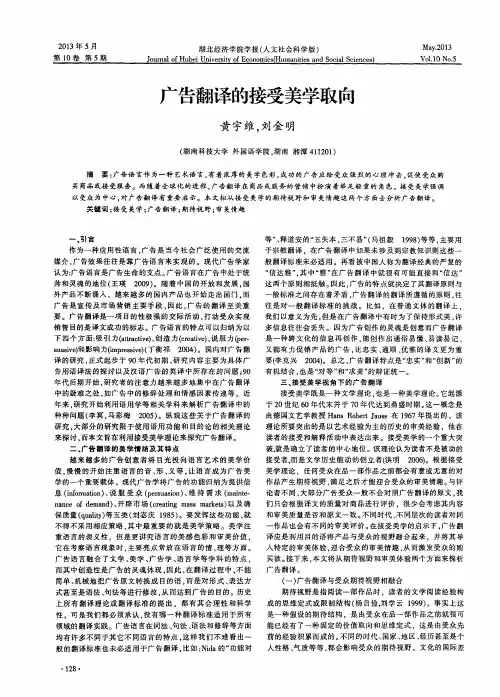
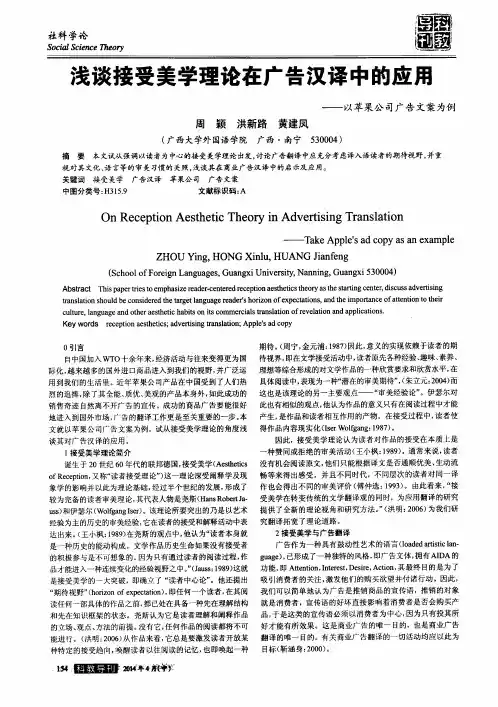
社科学论Soci al S c i ence Theor y浅谈接受美学理论在广告汉译中的应用——以苹果公司广告文案为例周颖洪新路黄建凤(广西大学外国语学院广西南宁530004)摘要本文试从强调以读者为中心的接受美学理论出发,讨论广告翻译中应充分考虑译入语读者的期待视野,并重视对其文化、语言等的审美习惯的关照,浅谈其在商业广告汉译中的启示及应用。
关键词接受美学广告汉译苹果公司广告文案中图分类号:H315.9文献标识码:AO n R ecept i on A e st he t i c T heor y i n A dver t i si ng T r ans l at i on——T al【e A ppl e’S ad copy as an exam pl eZ H O U Y i ng,H O N G X i nl u,H U A N G J i anf eng(School of For e i gn Languages,G uangxi U ni ver s i t y,N a nni ng,G ua ngxi530004)A bs t r act Thi s pap er t r i es t o em pha s i ze r ea der-ce nt e r ed r ec ept i on ae st het i c s t he ory as t he st ar t i n g c ent e r,di s cuss a dver t i si ngt r ans l a t i on s hou l d be con s i dered t he t a r ge t l angu age r e ader's hor i zon ofe xpe c t a t i ons,a nd t he i m port ance ofa t t e nt i on t o t he i rc ul t ure,l a ngua geand ot her ae st het i c ha bi t s on it s com m er ci al s t r ans l a t i on of re vel a t i on and appl i cat i on s.K ey w or ds r ec ept i on ae st het i c s;adver t i s i ng t ra nsl a t i on;A ppl e’s ad co py0引言自中国加入W T O十余年来,经济活动与往来变得更为国际化,越来越多的国外进口商品进入到我们的视野,并广泛运用到我们的生活里。

广告翻译不仅要确保广告原文的语言和风格的再现,还要考虑目标语受众的心理感受,下面是小编搜集的一篇相关,欢迎阅读参考。
引言二十世纪的西方文论可谓流派纷呈,名家蜂起。
以俄国形式主义为开端,先后历经结构主义、解构主义、符号学、阐释学、精神分析、接受、后殖民主义等发展阶段,其中接受美学以其深厚的德国功底和康士坦茨青年学者用“读者一接受”的系统研究为突破口而显得异军突起,脱颖而出,并最终走向西方文坛和世界文坛,产生了强烈的轰动效应。
和以往的研究不同,接受美学改变了原有的思维范式,由文本转向读者,更多的是关注经验读者对作品的心理反应和接受状况,这无疑开启了作者与读者之间的平等对话,是以全新的视角来研究文本存在的价值和意义的。
可以说,译文的成败很大程度上取决于目标语受众对译文的理解和接受。
而广告因其劝说功能明显,且作为一种传播媒体具有受众面广和间接产生商品经济效益的特性,翻译过程中更加凸显译者、作者、读者三者之间的“共谋”关系。
一则好的广告翻译往往会起到产品促销的作用,而一则不成功的广告翻译则可能影响产品的销售,受众对译文的心理反应至关重要。
1接受美学理论的主要观点从文本到读者,接受美学完成了研究的一次转向。
在过去的研究中,“西方自黑格尔将美学定义为‘理念的感性显现’以来,美学的目标就一直指向艺术的描述功能,艺术史被看作是作品及作者的历史,读者的作用几乎没被重视过;实证论的客观主义文史观,将文学史仅当成‘编年史一类的事实堆积’;的反映论和形式主义的文学史观,虽各有所取,但也都是‘把文学事实局限在生产美学与再现美学的封闭圈子内’,而忽视了读者的接受因素在文学史中的作用。
y”姚斯和伊瑟尔则不同,他们通过研读施莱格尔、茹尔茨、萨特等人的文论发现,经典作品背后隐藏着一个巨大的读者群,正是这个巨大的读者群推动着经典作品从一种解读向另一种解读迈进。
姚斯首次全面地提出了接受美学的基本观点,指出文学作品的价值与历史地位取决于创作意识与接受意识的合作。
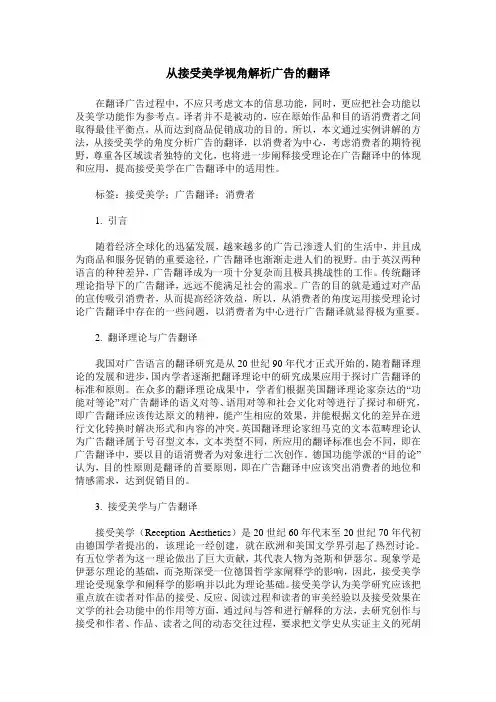
从接受美学视角解析广告的翻译在翻译广告过程中,不应只考虑文本的信息功能,同时,更应把社会功能以及美学功能作为参考点。
译者并不是被动的,应在原始作品和目的语消费者之间取得最佳平衡点,从而达到商品促销成功的目的。
所以,本文通过实例讲解的方法,从接受美学的角度分析广告的翻译,以消费者为中心,考虑消费者的期待视野,尊重各区域读者独特的文化,也将进一步阐释接受理论在广告翻译中的体现和应用,提高接受美学在广告翻译中的适用性。
标签:接受美学;广告翻译;消费者1. 引言随着经济全球化的迅猛发展,越来越多的广告已渗透人们的生活中,并且成为商品和服务促销的重要途径,广告翻译也渐渐走进人们的视野。
由于英汉两种语言的种种差异,广告翻译成为一项十分复杂而且极具挑战性的工作。
传统翻译理论指导下的广告翻译,远远不能满足社会的需求。
广告的目的就是通过对产品的宣传吸引消费者,从而提高经济效益,所以,从消费者的角度运用接受理论讨论广告翻译中存在的一些问题,以消费者为中心进行广告翻译就显得极为重要。
2. 翻译理论与广告翻译我国对广告语言的翻译研究是从20世纪90年代才正式开始的,随着翻译理论的发展和进步,国内学者逐渐把翻译理论中的研究成果应用于探讨广告翻译的标准和原则。
在众多的翻译理论成果中,学者们根据美国翻译理论家奈达的“功能对等论”对广告翻译的语义对等、语用对等和社会文化对等进行了探讨和研究,即广告翻译应该传达原文的精神,能产生相应的效果,并能根据文化的差异在进行文化转换时解决形式和内容的冲突。
英国翻译理论家纽马克的文本范畴理论认为广告翻译属于号召型文本,文本类型不同,所应用的翻译标准也会不同,即在广告翻译中,要以目的语消费者为对象进行二次创作。
德国功能学派的“目的论”认为,目的性原则是翻译的首要原则,即在广告翻译中应该突出消费者的地位和情感需求,达到促销目的。
3. 接受美学与广告翻译接受美学(Reception Aesthetics)是20世纪60年代末至20世纪70年代初由德国学者提出的,该理论一经创建,就在欧洲和美国文学界引起了热烈讨论。
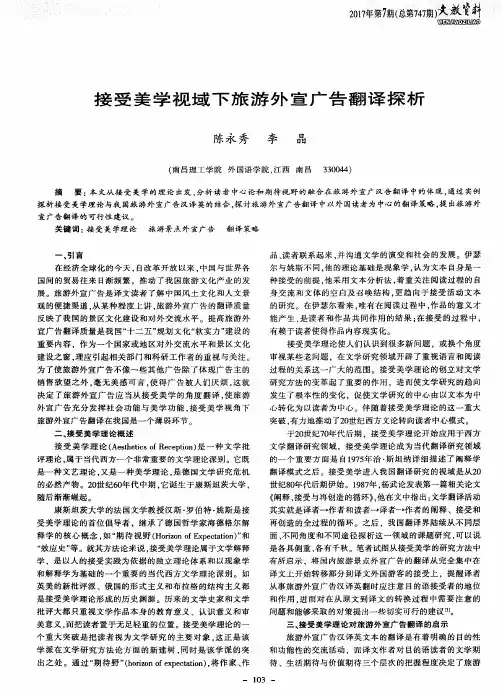
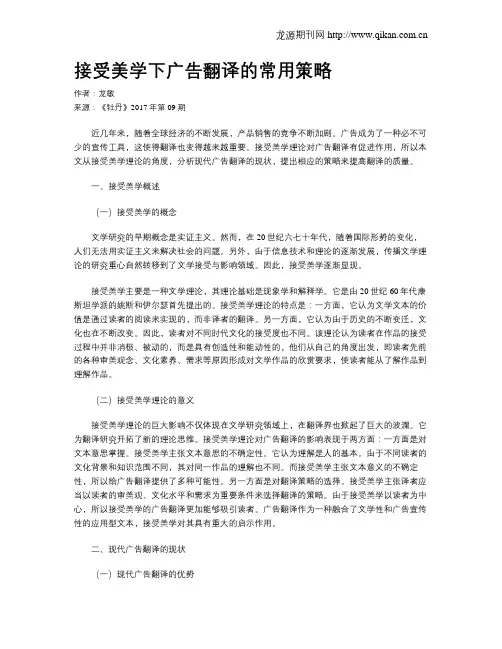
接受美学下广告翻译的常用策略作者:龙敏来源:《牡丹》2017年第09期近几年来,随着全球经济的不断发展,产品销售的竞争不断加剧。
广告成为了一种必不可少的宣传工具,这使得翻译也变得越来越重要。
接受美学理论对广告翻译有促进作用,所以本文从接受美学理论的角度,分析现代广告翻译的现状,提出相应的策略来提高翻译的质量。
一、接受美学概述(一)接受美学的概念文学研究的早期概念是实证主义。
然而,在20世纪六七十年代,随着国际形势的变化,人们无法用实证主义来解决社会的问题。
另外,由于信息技术和理论的逐渐发展,传播文学理论的研究重心自然转移到了文学接受与影响领域。
因此,接受美学逐渐显现。
接受美学主要是一种文学理论,其理论基础是现象学和解释学。
它是由20世纪60年代康斯坦学派的姚斯和伊尔瑟首先提出的。
接受美学理论的特点是:一方面,它认为文学文本的价值是通过读者的阅读来实现的,而非译者的翻译。
另一方面,它认为由于历史的不断变迁,文化也在不断改变。
因此,读者对不同时代文化的接受度也不同。
该理论认为读者在作品的接受过程中并非消极、被动的,而是具有创造性和能动性的,他们从自己的角度出发,即读者先前的各种审美观念、文化素养、需求等原因形成对文学作品的欣赏要求,使读者能从了解作品到理解作品。
(二)接受美学理论的意义接受美学理论的巨大影响不仅体现在文学研究领域上,在翻译界也掀起了巨大的波瀾。
它为翻译研究开拓了新的理论思维。
接受美学理论对广告翻译的影响表现于两方面:一方面是对文本意思掌握。
接受美学主张文本意思的不确定性。
它认为理解是人的基本。
由于不同读者的文化背景和知识范围不同,其对同一作品的理解也不同。
而接受美学主张文本意义的不确定性,所以给广告翻译提供了多种可能性。
另一方面是对翻译策略的选择。
接受美学主张译者应当以读者的审美观、文化水平和需求为重要条件来选择翻译的策略。
由于接受美学以读者为中心,所以接受美学的广告翻译更加能够吸引读者。
接受美学视角下英语化妆品广告修辞汉译研究全文共10篇示例,供读者参考篇1Title: Exploring the Rhetoric Translation of Cosmetic Advertisements from the Aesthetic PerspectiveHi everybody! Today, let's talk about something super cool - cosmetic advertisements! Have you ever seen those ads that make you want to buy all the makeup in the world? Well, guess what? We're going to dive deep into how these ads use language to make us feel all fancy and fabulous.First things first - what's rhetoric? Rhetoric is basically the art of persuasion through language. And in the world of cosmetic advertisements, rhetoric plays a huge role in convincing us that we absolutely NEED that new lipstick or eyeshadow palette.Now, let's talk about translation. When we see an ad in English, it might sound super fancy and sophisticated. But when it's translated into Chinese, how do they make sure it still sounds just as convincing and appealing?One way they do this is by using the beauty of the Chinese language to convey the same emotions and ideas as the English ad. They might use different words or phrases that have a similar impact on the audience.For example, if an English ad says "Get flawless skin with our new foundation," a Chinese translation might say something like ",," (Let your skin be flawless and perfect like a painting, our new foundation gives you a perfect experience). See how they use beautiful language to make you feel like you absolutely must have that foundation?!So next time you see a cosmetic ad, pay attention to the words they use and how they make you feel. And remember, beauty is not just about makeup, it's about feeling confident and comfortable in your own skin. Thanks for reading, beauties! See you next time!篇2Hey guys! Today I want to talk about a cool study about makeup ads using aesthetic perspective. It's like, when we see those ads for makeup on TV or online, they always make it look so amazing, right? But have you ever thought about why theyuse certain words or images to make us want to buy the product?This study is all about how makeup ads use language and visuals to make us feel like we need to have that product. It's like, they use words like "perfect" or "flawless" to make us think that if we use this makeup, we'll look perfect too. And they use images of models with really smooth skin or shiny hair to make us think that if we use this makeup, we'll look just like them.But the thing is, not everyone looks like those models in the ads. And that's where the aesthetic perspective comes in. It's all about how we see beauty in different ways. So maybe we don't need to look like those models to feel beautiful. Maybe we can find our own beauty in different ways.So next time you see a makeup ad, think about the words and images they use. Do they make you feel like you need to buy the product to be beautiful? Or do they make you feel like you're already beautiful just the way you are? It's important to think about these things and remember that beauty comes in all shapes and sizes. Let's embrace our own unique beauty and not get caught up in what the ads are trying to sell us. You're beautiful just the way you are!篇3I'm a little kid, and I'm gonna tell you about this really cool study on English makeup ads from a fancy point of view called aesthetics. So basically, this study looks at how makeup ads use language to make their products sound super awesome and appealing to us.First of all, let's talk about this thing called "rhetoric." It's like how companies use words and phrases to persuade us to buy their stuff. For example, they might say a mascara will give you "long, lush lashes" to make you feel like you absolutely need it.Then there's this thing called "translation." It's when they take fancy words from other languages and use them in their ads to sound more high-class. Like saying a moisturizer will make your skin "radiant" instead of just saying it'll make you glow.And lastly, there's this thing called "metaphor." It's when they compare their makeup to something else to make it seem even better. Like saying a lipstick will give you "kissable lips" to make you think you'll be super attractive if you wear it.So, next time you see a makeup ad, pay attention to all the sneaky language tricks they use to make you want to buy theirproducts. And remember, it's all just words – what really matters is how you feel when you wear makeup, not what the ad says!篇4Title: Super Cool Essay on English Makeup Advertisements from Aesthetic PerspectiveHey guys! Today we are going to talk about something super interesting - English makeup advertisements! Have you ever noticed how persuasive and cool those ads are? Well, it's all thanks to the beauty of language and the power of persuasion!First of all, let's talk about the aesthetics of these ads. They always use beautiful models and stunning visuals to catch our attention. They make us think, "Wow, I want to look like that too!" And that's how they draw us in. They appeal to our senses and make us want to try out their products.Secondly, the language they use is super important. Have you ever noticed how they always use words like "flawless," "radiant," and "perfect"? These words are meant to make us feel like we will be flawless and perfect too if we use their products. It's a clever trick, but it works!Another cool thing about these ads is how they talk about the benefits of their products. They always talk about how their makeup will make us look younger, more beautiful, and more confident. And who doesn't want that, right? It's like they are selling us a dream of being our best selves.In conclusion, English makeup advertisements are super cool because they use beautiful visuals, persuasive language, and appealing benefits to draw us in. Next time you see an ad, pay attention to these things and see if you can spot all the tricks they use to make us want to buy their products. Who knows, maybe you'll become a makeup ad expert too!篇5One day, I watched a super cool video about English makeup ads research. The video was all about how makeup ads use different tricks to make us want to buy their products. It was so interesting!First, they talked about how ads use beautiful words to describe their makeup. Words like "radiant," "flawless," and "glowing" make us think that if we buy the product, we will look just like the models in the ads. It's like they're promising us that we'll be super pretty if we use their makeup.Next, the video showed how ads use celebrities to advertise their makeup. When we see our favorite celebrities using a certain makeup brand, we want to use it too. It's like we think that if we use the same makeup as them, we'll be as cool and stylish as they are.Then, they talked about how ads use before and after pictures to show us how amazing their makeup is. They show a regular person looking kind of blah without makeup, and then after using the product, they look super awesome. It makes us think that if we use the makeup, we'll have a total makeover too.Overall, the video taught me that makeup ads are super sneaky. They know just how to use words, celebrities, and pictures to make us want to buy their products. It's like they're playing tricks on us, but it's kind of fun too. Now I'll be more careful when I see makeup ads and remember that they're just trying to sell me stuff.篇6Oh, hi there! Today I want to talk to you about this super cool research paper about English makeup ads from a aesthetics perspective. It's going to be so much fun!So, the paper is all about studying how makeup brands use language in their ads to make their products sound amazing and make us want to buy them. It's like they use all these fancy words and phrases to make us think their products are the best thing ever.The researchers looked at a bunch of makeup ads and analyzed the words and phrases they used. They found that a lot of ads use words like "luxurious", "innovative", and "revolutionary" to describe their products. And they use really flowery language to make us feel like we absolutely need to have their products.But here's the thing - not all of these words are actually true. Sometimes, makeup brands use these words to make their products sound better than they actually are. It's like they're tricking us into thinking their products are amazing when they're really just okay.But hey, that's just how advertising works, right? They want us to buy their products, so they use all these tricks to make us want them. It's pretty sneaky, but also kind of fun to study.In conclusion, makeup ads use a lot of fancy language to make their products sound amazing. But we should always be critical and think about whether the products are really as greatas they say. So next time you see a makeup ad, remember to take it with a grain of salt!And that's it for today's research paper review. Thanks for listening, and I'll see you next time!篇7Title: Fun Study on Translating and Analyzing Makeup Advertisement Rhetoric from Aesthetic PerspectiveHey guys! Today we are going to talk about something super cool and fun – translating and analyzing makeup advertisement rhetoric from an aesthetic perspective. I know it sounds a bit fancy, but don't worry, I'll make it super easy to understand!So, first things first, what is rhetoric? Rhetoric is basically the art of using language to persuade or impress people. And when it comes to makeup ads, rhetoric is used to make the products sound amazing and irresistible.Now, let's talk about translating makeup ads into Chinese. When we translate these ads, we need to make sure that we capture the beauty and excitement of the original English text.We want our Chinese readers to feel the same way as the English speakers when they read the ad.Next, let's talk about analyzing makeup advertisement rhetoric. In these ads, you will often see words like "radiant," "flawless," and "glow." These words are used to create a sense of beauty and perfection. The ads also use images of beautiful models to make the products seem even more desirable.Overall, translating and analyzing makeup advertisement rhetoric is a super fun and interesting topic. It helps us understand how language can be used to create a certain mood or feeling. And who knows, maybe one day you'll be creating your own amazing makeup ads! Keep on learning and exploring, guys!篇8Oh wow, have you ever seen those fancy makeup ads on TV? They always talk about how their products are so amazing and can make you look beautiful! But have you ever thought about how they use language to persuade us to buy their makeup?In this article, we are going to explore the world of makeup ads from a aesthetic perspective and see how they use cleverlanguage tricks to convince us to buy their products. So buckle up and get ready to dive into the world of English makeup ads!First off, let's talk about how these ads use visual imagery to make their products seem more appealing. They always show models with flawless skin and perfect makeup, making us think that if we use their products, we can look just as amazing. This is called visual rhetoric, and it plays a big role in makeup ads.Next, let's discuss how these ads use language to make their products sound irresistible. They often use words like "magical", "transformative" and "luxurious" to describe their products, making us feel like we absolutely need them in our lives. This is called persuasive rhetoric, and it's a powerful tool in the world of advertising.Overall, makeup ads are not just trying to sell us products, they are trying to sell us a dream of looking beautiful and confident. By using clever language tricks and visual imagery, they make their products seem like a must-have for anyone who wants to feel their best. So next time you see a makeup ad, remember to think about the words they are using to convince you to buy their products. It's all part of the magical world of English makeup ads!篇9Beauty is everywhere, from the colorful flowers in the garden to the bright stars in the night sky. But did you know that we can also find beauty in makeup products? In this article, we will explore the world of beauty through the eyes of aesthetics and take a closer look at English makeup advertisements.First of all, let's talk about what aesthetics is. Aesthetics is all about beauty and art, it's like a magic wand that can make everything look more beautiful. When we talk about makeup advertisements from an aesthetic point of view, we are looking at how these ads use language and images to make their products look more appealing and desirable.In English makeup advertisements, you will often see words like "radiant," "flawless," and "glowing." These words are carefully chosen to create a sense of beauty and perfection. They make us feel like we can achieve the same flawless look if we use the product being advertised. It's like a secret spell that promises to transform us into our most beautiful selves.In addition to words, images also play a big role in makeup advertisements. Have you ever noticed how the models in these ads always have perfect skin and shiny hair? These images aremeant to show us how beautiful we can be if we use the product. It's like a glimpse into a world where everyone is flawless and glamorous.Overall, English makeup advertisements are like a fairy tale come to life. They use words and images to create a world where beauty is the ultimate goal. So next time you see a makeup ad, take a moment to appreciate the beauty and artistry behind it. Who knows, maybe you'll find a little magic in that tube of lipstick or jar of foundation.篇10Sure! Here is a brief and simplified English version of the article on the study of English makeup advertisements from an aesthetic perspective:---Hey guys! Today let's talk about English makeup ads and how they use fancy words to make their products sound super cool. Have you ever noticed how makeup ads always talk about how amazing their products are? Well, that's because they use a special kind of language called rhetoric to make us feel like we need their products.So, what is rhetoric? It's basically using persuasive language to convince people to do or buy something. In makeup ads, they use words like "flawless," "radiant," and "perfect" to make us feel like we need their products to look beautiful. They also use images of super pretty models with flawless skin to make us think we can look just like them if we use their products.But how do these ads make us feel so excited about makeup? Well, they manipulate our emotions by using language that appeals to our senses. For example, they might say a foundation will make your skin feel "silky smooth" or a lipstick will make your lips "soft and kissable." These words create a picture in our minds of how amazing we will look and feel when we use their products.In conclusion, English makeup ads are not just about selling products, they are also about making us feel confident and beautiful. So next time you see a makeup ad, remember to think critically about the words they use and how they make you feel. And always remember, true beauty comes from within!。
接受美学视角下广告语修辞的汉译策略研究以欧美化妆品广告为例一、概述在全球化背景下,广告语作为商品营销的重要手段,其翻译质量直接关系到商品在目标市场的接受度和影响力。
接受美学理论强调以读者的接受和反应为中心,为广告语修辞的汉译策略研究提供了新的视角。
本文以欧美化妆品广告为例,旨在探讨在接受美学视角下,如何有效地进行广告语修辞的汉译,以达到最佳的传播效果和市场接受度。
欧美化妆品广告以其独特的创意和修辞手法,在全球范围内享有广泛的知名度和影响力。
由于文化差异和语言特性的存在,其广告语的汉译并非易事。
如何在保持原意的基础上,充分考虑目标受众的文化背景和审美习惯,使译文既符合汉语表达习惯,又能引起消费者的共鸣,是本文研究的核心问题。
接受美学理论强调读者的主体地位和接受过程的重要性,认为翻译不仅仅是语言的转换,更是文化的传递和接受。
在广告语修辞的汉译过程中,需要充分考虑目标受众的接受心理和审美需求,选择恰当的翻译策略和方法,以实现广告语的有效传播和市场接受。
本文将从接受美学的视角出发,结合欧美化妆品广告的具体案例,分析广告语修辞的特点和翻译难点,探讨如何在汉译过程中运用恰当的翻译策略和方法,以提高广告语的传播效果和市场接受度。
本文还将对汉译过程中的问题进行总结和反思,以期为今后的广告语翻译提供有益的借鉴和启示。
1. 接受美学理论概述又称为接受理论,是20世纪60年代中期在联邦德国兴起的一种文学批评理论。
其首倡者汉斯罗伯特姚斯在《文学史作为文学科学的挑战》为接受美学成为独立学派奠定了理论基础。
接受美学的主要观点在于强调读者在文学活动中的主动性和决定性地位,认为作品的教育功能和娱乐功能在读者的阅读过程中得以实现,这一实现过程同时也是作品获得生命力和最终完成的过程。
在接受美学视角下,文学文本和文学作品是两个性质不同的概念。
文本指的是作家创造的尚未与读者发生关系的作品本身,而作品则是指与读者构成对象性关系的东西,它融入了读者的经验、情感和艺术趣味,成为审美的对象。
从接受美学的视角论述广告翻译广告作为商业传播的重要方式之一,扮演着推动产品销售、塑造品牌形象的重要角色。
而广告翻译作为将广告文本从一种语言转化为另一种语言的过程,同样具有非常重要的作用。
本文将从接受美学的视角,探讨广告翻译的重要性及其对广告影响的因素。
首先,广告翻译对于传递准确信息至关重要。
广告的翻译需要保持原文的信息准确性和完整性,确保目标受众能够准确理解广告所传达的产品特点和优势。
好的广告翻译应该能够准确传达原文中的情感和语气,使目标受众在不同文化背景下能够感受到相似的情绪和体验。
其次,广告翻译需要兼顾文化差异。
不同国家和地区的文化背景和价值观差异会对广告的理解和接受产生影响。
因此,广告翻译需要根据目标受众的文化特点进行调整,使其更符合目标受众的审美观念和文化习惯。
这就要求广告翻译者具备深入了解不同文化背景的能力,能够将广告信息进行有效的转化,以便更好地吸引目标受众的注意力。
此外,广告翻译需要考虑目标受众的语言习惯和口味。
语言是文化的重要组成部分,不同语言有着不同的表达方式和修辞手法。
广告翻译需要根据目标受众的语言特点,选择合适的表达方式和修辞手法,使广告在翻译后仍然能够引起目标受众的共鸣和兴趣。
同时,广告翻译还需要考虑目标受众的口味和喜好,以便更好地满足其需求。
最后,广告翻译要注重创意与创新。
广告作为商业传播的一种形式,需要吸引目标受众的注意力,并激发其购买欲望。
好的广告翻译应该能够将原文中的创意和创新元素传达给目标受众,使其产生共鸣并受到吸引。
广告翻译者需要具备创造力和创新意识,能够在翻译过程中加入自己的创意和想法,以便更好地实现广告的传播效果。
综上所述,从接受美学的视角来看,广告翻译在传递准确信息、兼顾文化差异、考虑语言习惯和口味以及注重创意与创新等方面都具有重要作用。
只有在这些因素的综合影响下,广告翻译才能够更好地实现其传播效果,吸引目标受众的注意力,并推动产品的销售。
因此,广告翻译需要广告公司和翻译者共同努力,不断加强专业能。
《长江丛刊·理论研究》2017.03从接受美学角度看化妆品广告的汉译苏红瑞【摘 要】随着世界一体化步伐的加快,大量外国化妆品品牌涌入中国市场,外来化妆品是否能得到中国消费者的认可与接受,不仅取决于化妆品本身是否适合中国女性的肤质,功效如何,还在很大程度上取决于这些化妆品的汉译名称是否符合中国消费者的心理预期,是否能考虑到中国消费者的审美与感受,从而抓住中国消费者的心理需求,刺激其购买欲望,最终达到化妆品销量不断增加的目的。
本文以接受美学为理论出发点,探讨接受美学对化妆品广告汉译的启示并在接受美学理论指导下研究化妆品广告汉译的具体策略,旨在帮助提高化妆品广告汉译的质量,让其获得更多的商业受众。
【关键词】接受美学 化妆品广告 汉译一、前言作为具有特殊功能的商品,化妆品很受广大消费者尤其是女性消费者的青睐。
近年来,随着世界一体化步伐的加快,许多欧美公司的化妆品涌入中国市场,如何在竞争激烈的市场中取得一席之地,赢得中国消费者的接受和认可,化妆品广告语作为打入市场的关键一环,如何被翻译显得至关重要。
接受美学主张翻译应把译文读者为主体,把握读者的接受性和能动性,本文将从接受美学的角度出发,探讨接受美学对化妆品广告翻译的启示并在接受美学理论指导下研究化妆品广告汉译的具体策略。
二、接受美学及其对广告翻译的借鉴意义联邦德国文学史专家和文学美学家W.伊泽尔和H.R.姚斯在20世纪60年代末70年代初提出了接受美学理论,该理论认为由自然、人、社会构成的世界是作家创作作品的源泉,作品是否有意义,取决于读者的审美接受。
从本质上说,作品是为读者创造的,读者是文学活动的能动主体,作品只有被读者阅读了,在读者的阅读过程中,作品才能进入一种连续变化的经验视野之中。
广告语言正是利用其自身传递信息和说服劝诱的功能,引起顾客对商品的注意、好奇和兴趣,并潜移默化地激发其购买欲望。
广告语翻译者的审美价值应与消费者的审美价值体验吻合,广告语翻译的宗旨应该是唤起消费者对过去某种美好的记忆或将其诱导入某种美好的体验中,在阅读广告译文的过程中,顾客的期待若能被激发、被实现,这就说明顾客心动了,有心动才能有购买行动,所以,可以从接受美学的角度出发来研究化妆品广告的汉译。
从接受美学视角探讨广告翻译
(河海大学外国语学院英语系, 江苏南京210098)
广告在商业化时代的作用举足轻重,广告翻译是商品进军国际市场的主要手段。
从接受美学理论的视角研究广告翻译是一个新的研究方法。
广告译者应以读者为中心,考虑受众的视野期待和审美情趣,唤醒读者的想象和欲望,从而达到促销目的。
标签:接受美学;广告翻译;读者中心
1引言
随着经济全球化的推进,各国商品开始在世界市场上流通,全球的商品经济竞争愈演愈烈。
推销本国产品的一个重要手段就是广告宣传。
如今,中外企业都面临着商务广告与国际接轨的问题,即广告翻译的问题。
广告是一种实用性很强的文体,能否打动读者是广告翻译成功与否的标志。
本文从接受美学理论的角度来探讨如何做好广告翻译以达到预期效果。
2接受美学简论
接受美学(Aesthetics of Reception)又称接受理论,是20世纪60年代出现的一种文学美学思潮。
其代表人物有德国康斯坦茨学派的尧斯(hans Robert Jauss)和伊瑟尔(Wolfgang Iser)。
接受美学将读者提升到突出重要的地位,把文学史看成“读者
的文学史”,认为“文学作品从根本上是注定为接受者而创作的”。
其主要观点有:
读者中心论:一部作品生命的长短取决于读者的接受。
尧斯认为,在作家、作品和读者的三角关系中,后者不是被动的因素或单纯做出反应的环节,它本身便是一种再创造历史的力量。
在接受活动开始之前,任何读者已有自己特定的“期待视野”,即“对每部作品的独特的意向”,又称对某类作品的“前理解”(pre-understanding)。
这一阅读前的意向和视野决定了读者对作品的取舍标准、决定了他阅读中的选择与重点、也决定了他对作品的态度与评价。
审美经验论:读者在阅读作品之前,头脑中已有一系列自觉或不自觉的准备,如审美经验、生活经验和鉴赏能力等。
当新作品唤起读者对同类或有关作品的过去的审美经验时,读者会把过去的经验视界和眼前的作品所体现的新视界做出想象的对比。
审美经验使人产生一种潜反射的审美态度,如读者在生活中接触到大量的人物事件,在阅读中发现有虚假现象就会自然的产生一种抵制接受,形成与作品的审美意象对峙的观点。
召唤结构说:阅读是读者想象性再创造的过程。
一部作品的本文“为读者唤起熟知的来自较早本文的期待和规则的世界,那样,这些较早的本文就被改动、修正、
改变,或者甚至干脆重新制作了”。
所以,作品的意义更多的在于唤起或更改读者的记忆。
文学文本总是有许多的空白,等待读者在阅读过程中调动想象去填充。
伊瑟尔指出,唤起读者填补空白、连接空缺、建立新视界的结构,即本文的召唤结构,用来呼唤读者完全进入文本所组建的情境之中,它可以激发读者想象,使其在阅读中填充作品潜在的审美价值。
3接受美学理论指导下的广告翻译
根据接受美学理论,任何读者在进行阅读活动之前,都会有意识或无意识地对作品产生特定的期待视野。
接受美学强调以读者为中心,满足读者的期待视野和审美情趣;要求作家赋予作品足够的意义“不确定性”和“空白”,召唤读者潜在的想象力,达到作品的预期效果。
在接受美学的启示下,广告翻译的宗旨应是唤醒读者的记忆,将其导入特定的体验中并唤起他们的期待,然后在购买行动中激发或改变这种期待。
3.1以读者为主体,满足或高出消费者的期待视野
接受美学对广告翻译的最大启示是把重心移向读者。
广告宣传的效果能否实现,关键取决于受传者是否接受这个宣传。
为了成功实现广告翻译目的,译者必须关照读者,把握其主观能动性,与读者在视野上相互融合。
“期待视野”是指在阅读作品时,读者的文学阅读经验构成的思维定式或现在结构。
它是读者在阅读之前可能赋予某作品的思维定向,是由读者先前的欣赏水平和经验素养积累而成的。
期待视野使译者感受到读者的需要,不知不觉地跟随着“潜在读者”去翻译。
读者期待视野在广告中表现为消费者的接受准备。
成功的广告翻译要让消费者能在广告中找到与其期待视野的契合之处,或是高于其期待视野之处,从而接受这则广告。
例如,耐克的广告“just do it(跟着感觉走)”体现了商家尊重作为个体的消费者,符合受众(运动群体)的期待,即凸显个性、彰显自我,因而容易被接受。
又如,某典当行广告语“上当不吃亏”,若是采用逐字翻译必然会激起读者的先前经验,即他们认为典当是落魄和丢脸的。
如果译成:“Go to the Pawn, You won’t be Down.”便有效地避免了读者对典当行的恐惧和抵触心理。
3.2了解读者的审美情趣,充分调动消费者的审美体验
接受美学理论指出,读者在阅读作品前已有一定的生活经验和审美体验,这直接影响到他们对作品的评价和接受程度。
调动读者的审美情趣是广告翻译的关键环节,译前必须了解目标群体的审美心理,有针对性的译出符合他们审美要求的广告文本,进而激发他们的购买欲望。
成功的广告常使用优美的措辞来营造美妙的意境,以扣动读者的心弦,使其在获得审美的同时,能产生联想。
例如,某香水的广告“Her smile could heat up a nation. Her fragrance captured a
country.”译成“迷魂牵魂笑貌,倾国倾城芳香”,有效地迎合了女性消费者的爱美心理,与读者达到了审美体验的完整融合。
优美的语言可以激发起消费者对产品的美好感受,然后使她们联想这款香水的魅力和无限吸引力,从而激励她们去购买。
又如,某茶叶广告:“开汤审评,清香四溢,滋味鲜醇,回味甘甜,余香犹存”译文“Being fragrant, refreshing and mellow, your tea presents a lingering after-taste of mild mellowness.”,一系列的形容词增添了读者对茶的美感体验,具有强烈的美感功能,能激起消费者想马上去尝试的冲动。
3.3构建能唤起读者想象的译本结构,实现广告的召唤功能
为了实现广告的移情功能,广告翻译要有吸引力,唤醒消费者的情感和想象。
如较多的使用反问句,唤起消费者对产品的好奇心。
让读者在试图回答问题中主动地参与,从而使其进入广告的角色,完全沉浸于广告所创造的气氛中。
例如,别克汽车广告“Wouldn’t you really rather have a Buick?” 的译文“难道你不愿拥有一辆别克车吗?”巧妙地使用汉语的“难道”句型,唤起读者的共鸣,让他们对别克车有着无限的遐想,将读者引入一个译者创造的美好氛围中,激起他们的欲望。
又如另一则广告:“让WIC妇孺计划帮助您”。
译成“Let WIC work for you.”。
由于西方消费者提倡独立,反对依赖。
如果将“帮助”译成“help” 效果很可能会适得其反,译文巧妙的使用“work for”,让国外消费者感受到广告的译者尊重他们的自主性,从而参与到这个独立工作的活动中来。
4结语
接受美学理论为广告翻译提供了全新的理论视角和研究方法。
译者应以读者为中心,揭示出广告的信息和价值,充分考虑到消费者的期待视野和审美经验,将其引入特定的氛围,唤起他们对产品的想象和渴望。
这就要求译者具有足够的审美素养和语言文化的驾驭能力。
在迎合读者口味的同时,译者还应构建出适当高于读者期待视野的文本,提高大众的品味,吸引和说服消费者的同时推动文化进步。
参考文献
[1]朱立元. 接受美学导论[M]. 合肥:安徽教育出版社,2004.
[2]杨自俭,刘学云. 翻译新论[M]. 武汉:湖北教育出版社,1999.
[3]洪明. 论接受美学与旅游外宣广告翻译中的读者关照[J]. 外语与外语教学,2006,(8).
[4]靳涵身. 商业广告翻译:性质、特点、技巧[J]. 四川外语学院学报,2000,(3).。